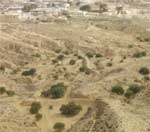


"Effective prevention of desertification requires both local management and macro policy approaches that promote sustainability of ecosystem services. It is advisable to focus on prevention, because attempts to rehabilitate desertified areas are costly and tend to deliver limited results." More...

In order to prevent and reverse desertification, major policy interventions and changes in management approaches are needed. Such interventions should be implemented at local to global scales, with the active engagement of stakeholders and local communities.
Societal and policy actions need to adjust to the degree of desertification that a society faces or is likely to face. In areas where desertification processes are at the early stages or are relatively minor, it is possible to stop the process and restore key services in the degraded areas. Prevention is a lot more cost-effective than rehabilitation, and this should be taken into account in policy decisions.
Addressing desertification is critical and essential to meeting the Millennium Development Goals which aim to eradicate extreme poverty and ensuring environmental sustainability amongst other objectives.
On average, human populations in drylands have a lower quality of life than people in other areas. Worldwide, approximately half of the people living below the poverty line live in drylands and their societies are particularly vulnerable as a result of dryland ecosystem conditions and poverty. Addressing desertification would therefore contribute to the eradication of extreme poverty and hunger. More...

The creation of a "culture of prevention" can go a long way toward protecting drylands when desertification is just beginning and even when it is ongoing. It requires a change in governments’ and peoples’ attitudes. It has been shown that dryland populations, building on long-term experience and active innovation, can stay ahead of desertification by improving agricultural and grazing practices in a sustainable way.
Preventive actions include:
Rehabilitation and restoration approaches can help restore ecosystem services that have been lost due to desertification. Restoration aims to reestablish a previous ecosystem state and all its functions and services, while rehabilitation seeks to repair specific parts of the systems, in order to regain ecosystem productivity.
Effective restoration and rehabilitation of desertified drylands require a combination of policies and technologies and the close involvement of local communities.
Examples of actions to restore and rehabilitate ecosystems include:
Policies that create incentives for rehabilitation include capacity building, capital investment, and supportive institutions.
The success of rehabilitation practices depends on the availability of human resources, sufficient funds and infrastructures, as well as on the degree of dependence on external technologies and cultural perceptions. Adequate access to these resources can lead to successful rehabilitation of some ecosystem services and also help reduce poverty. When these conditions are not met, efforts to rehabilitate fail. Restoring degraded dryland services may thus be difficult even with major policy and technology interventions. More...

This summary is free and ad-free, as is all of our content. You can help us remain free and independant as well as to develop new ways to communicate science by becoming a Patron!